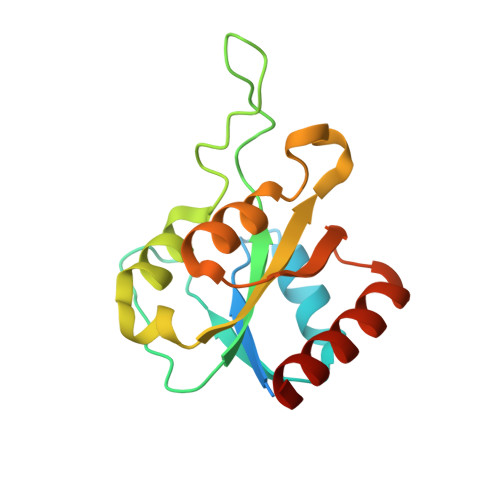Metal-free class Ie ribonucleotide reductase from pathogens initiates catalysis with a tyrosine-derived dihydroxyphenylalanine radical.
Blaesi, E.J., Palowitch, G.M., Hu, K., Kim, A.J., Rose, H.R., Alapati, R., Lougee, M.G., Kim, H.J., Taguchi, A.T., Tan, K.O., Laremore, T.N., Griffin, R.G., Krebs, C., Matthews, M.L., Silakov, A., Bollinger Jr., J.M., Allen, B.D., Boal, A.K.(2018) Proc Natl Acad Sci U S A 115: 10022-10027
- PubMed: 30224458
- DOI: https://doi.org/10.1073/pnas.1811993115
- Primary Citation of Related Structures:
6EBO, 6EBP, 6EBQ, 6EBZ - PubMed Abstract:
All cells obtain 2'-deoxyribonucleotides for DNA synthesis through the activity of a ribonucleotide reductase (RNR). The class I RNRs found in humans and pathogenic bacteria differ in ( i ) use of Fe(II), Mn(II), or both for activation of the dinuclear-metallocofactor subunit, β; ( ii ) reaction of the reduced dimetal center with dioxygen or superoxide for this activation; ( iii ) requirement (or lack thereof) for a flavoprotein activase, NrdI, to provide the superoxide from O 2 ; and ( iv ) use of either a stable tyrosyl radical or a high-valent dimetal cluster to initiate each turnover by oxidizing a cysteine residue in the α subunit to a radical (Cys•). The use of manganese by bacterial class I, subclass b-d RNRs, which contrasts with the exclusive use of iron by the eukaryotic Ia enzymes, appears to be a countermeasure of certain pathogens against iron deprivation imposed by their hosts. Here, we report a metal-free type of class I RNR (subclass e) from two human pathogens. The Cys• in its α subunit is generated by a stable, tyrosine-derived dihydroxyphenylalanine radical (DOPA•) in β. The three-electron oxidation producing DOPA• occurs in Escherichia coli only if the β is coexpressed with the NrdI activase encoded adjacently in the pathogen genome. The independence of this new RNR from transition metals, or the requirement for a single metal ion only transiently for activation, may afford the pathogens an even more potent countermeasure against transition metal-directed innate immunity.
Organizational Affiliation:
Department of Chemistry, The Pennsylvania State University, University Park, PA 16802.















